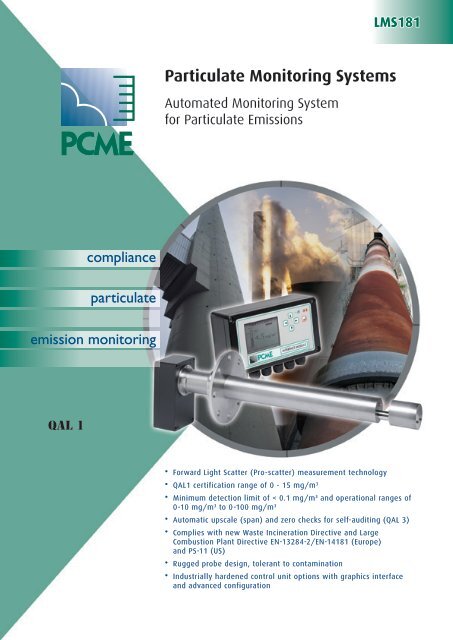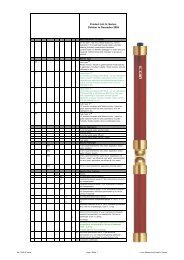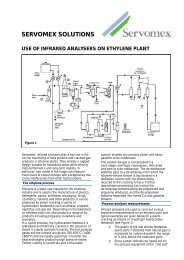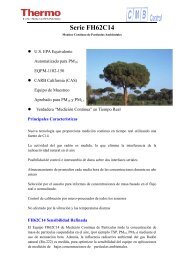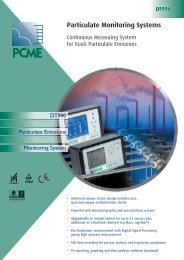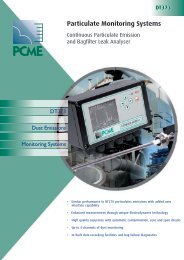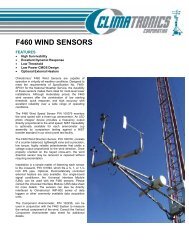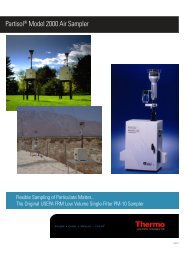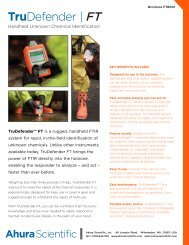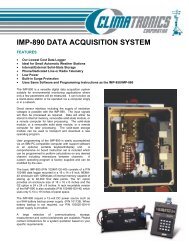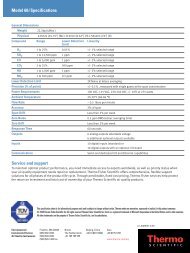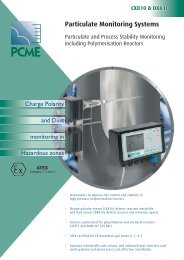LMS181 Particulate Monitoring Systems - CMB Control
LMS181 Particulate Monitoring Systems - CMB Control
LMS181 Particulate Monitoring Systems - CMB Control
You also want an ePaper? Increase the reach of your titles
YUMPU automatically turns print PDFs into web optimized ePapers that Google loves.
<strong>LMS181</strong><br />
<strong>Particulate</strong> <strong>Monitoring</strong> <strong>Systems</strong><br />
Automated <strong>Monitoring</strong> System<br />
for <strong>Particulate</strong> Emissions<br />
compliance<br />
particulate<br />
emission monitoring<br />
QAL 1<br />
• Forward Light Scatter (Pro-scatter) measurement technology<br />
• QAL1 certification range of 0 - 15 mg/m 3<br />
• Minimum detection limit of < 0.1 mg/m 3 and operational ranges of<br />
0-10 mg/m 3 to 0-100 mg/m 3<br />
• Automatic upscale (span) and zero checks for self-auditing (QAL 3)<br />
• Complies with new Waste Incineration Directive and Large<br />
Combustion Plant Directive EN-13284-2/EN-14181 (Europe)<br />
and PS-11 (US)<br />
• Rugged probe design, tolerant to contamination<br />
• Industrially hardened control unit options with graphics interface<br />
and advanced configuration
applications<br />
Continuous Stack Measurement<br />
The <strong>LMS181</strong> is suitable for measuring particle emissions after both bagfilter and electrostatic<br />
precipitator arrestment plant and is especially relevant where it is critical to obtain reliable,<br />
accurate and robust emissions data. The instrument has reduced cross-sensitivity to changing<br />
particle type and is unaffected by changes in velocity making it of interest to operators of all types<br />
of industrial processes where emissions are challenging to monitor using conventional methods.<br />
From a regulatory perspective, its high Quality Assurance features makes it also suitable as a<br />
compliance device to satisfy new standards for Incinerators, Power Stations and Cement Kilns.<br />
Specific requirements satisfied by the instrument are:<br />
• High quality dust measurement with minimal cross-sensitivity from particle type<br />
• Compliance to US EPA standard for PM-CEMS (PS-11) – see separate application note<br />
• Designed to meet CEN standard, EN-13284-2/EN-14181 for Incinerators, Power Plant and<br />
Cement Kilns<br />
Principle of Operation<br />
The <strong>LMS181</strong> measures the scattered forward light from a laser source. The measurement volume in the sensor probe is positioned in a<br />
representative location within the stack. The scattered light response is directly proportional to dust concentration. The instrument optimises its<br />
resolution and zero drift characteristics, meaning accurate measurement below 0.1 mg/m 3 as well as rugged operation in stacks where emissions<br />
exceed 100 mg/m 3 .<br />
The Pro-Scatter technique used in the <strong>LMS181</strong> collects the total cone of scattered light from particles in the measurement volume, resulting in a<br />
more representative measurement than point type scattering systems. This patented measurement method increases the instruments signal to<br />
noise ratio giving high stabilty at even low dust concentrations ( < 0.1 mg/m 3 ).<br />
Side scatter<br />
Back<br />
scatter<br />
Principle of Scattered Light<br />
Forward<br />
scatter<br />
Method of implimentation<br />
EN-14181 (13284-2) for Incinerators, Power Plant and Cement Kiln<br />
The <strong>LMS181</strong> provides users of processes regulated under the European WID and Large Combustion Power Plant Directive, a precise and robust<br />
solution for meeting EN-14181 (EN-13284-2) while reducing cost of ownership. Instrument standards require a QAL 1 assessment (with stated<br />
uncertainty) and suitable QAL 3 features for ongoing Quality Assurance (zero and span checks with appropriate statistical treatment).<br />
The <strong>LMS181</strong> is designed to meet these requirements and also providing suitable audit and reference materials for the Annual Surveillance Test (AST).<br />
The instrument provides a precise measurement of particulate concentration. Its calibration is less sensitive to changing particle type than higher<br />
angle light scattering and electrodynamic techniques. This feature can significantly reduce the need for expensive recalibrations (QAL2).<br />
Issues satisfied when used to meet EN-13284-2 Calibration to QAL 2<br />
Workplace <strong>Monitoring</strong><br />
The instrument can also be mounted in an open factory or ambient environment to<br />
continuously monitor the levels of particulate. The instrument is suitable for measuring<br />
stationary airstreams as well as an air volume from which a sample is drawn. The instrument is<br />
capable of monitoring the very low levels of particulate associated with particle contamination<br />
and clean work environments as well as the more substantial dust levels associated with<br />
explosive dust levels. The instrument has a unique and predictable response to known types<br />
of dust, meaning that its output can be pre-calibrated in mg/m 3 .<br />
Typical applications include:<br />
• Personal dust exposure monitoring<br />
• Automatic control of air extraction plant based on ambient dust levels<br />
• Contamination control<br />
• <strong>Monitoring</strong> dusts against LEL and HEL explosive ambient levels<br />
• Tunnel <strong>Monitoring</strong>
product features<br />
Connection Schematic<br />
The <strong>LMS181</strong> comprises the pro-scatter sensor which is mounted directly<br />
in the stack plus a powerful user interface module which provides<br />
power and digital communication for the sensor. The standard control<br />
unit provides set-up functionality, graphical displays and recording<br />
of emissions and QAL3 data for a single sensor system. This maybe<br />
extended up to 32 sensors and to include ethernet compatility (option).<br />
The control unit can also provide simmultaneous recording of the pulse<br />
data (for arrestment plant cleaning diagnosis), short term data (for<br />
process control) and long term data (for external emissions reporting).<br />
Both control units support inputs from external oxygen and temperature<br />
meaurements for on board normalisation. The sensor, which supports<br />
industry standard modbus communication, can be connected directly to<br />
a PLC or CEMs management system.<br />
QAL Reporter PC software is fully compatible with the instrument to<br />
provide secure and powerful emissions reporting and automated QAL3<br />
reporting in full compliance with EN-13284-2.<br />
Reliability and Contamination Resistance<br />
The instrument will work reliably in high dust applications due to the use of extended air curtains which protect all optical surfaces from the flue<br />
gas. The instrument can be connected to instrument compressed air or supplied with its own air blower unit which generates sufficient air for the<br />
instrument. The results of the automatic upscale (span) check can optionally be used to compensate for the effects of any contamination. The<br />
<strong>LMS181</strong> also operates reliably at elevated temperatures (optional to 400 o C) having the advantage of no active electronic or optical components<br />
exposed to stack temperature. The instruments patented design is inherently reliable by avoiding the use of fibre optics (which age with<br />
temperature) and the need for the movement of detectors for the self checks (which are postion critical).<br />
Self-checks for Compliance Measurement<br />
The <strong>LMS181</strong> includes automatic self-checks designed to ensure appropriate quality assurance and to meet the QAL 3 regulatory requirements for<br />
particulate compliance monitors installed on Incinerators, Cement Kilns and Power Plant in Europe (EN-13284-2). Appropriate zero and upscale<br />
(span) tests are included as standard.<br />
Measurement mode<br />
Span check with diffuser performs QAL3<br />
These checks ‘challenge’ the instruments performance, checking the operation of the transmitter and receiver optical and electronic components<br />
are within specification as well as the instruments accuracy in measuring scattered light. This permits any instrument failure or mis-measurement<br />
to be rapidly diagnosed and corrected. The diffuser introduced during the automatic span check simulates a scattered signal, meaning the check<br />
is a true check of the instruments ability to measure scattered light, rather than just attenuated light.<br />
Advanced, robust user interface<br />
The multicontroller (up to 32 sensors) is an industrially hardened display<br />
and recording system which provide advanced user interface and sensor<br />
configuration. These can be connected directly to a LAN or PC network<br />
for data management and recording via DustReporter 2 PC software.<br />
Graphics<br />
screen assists<br />
interpretation of<br />
emission trends<br />
On-board<br />
Normalisation<br />
for oxygen and<br />
temperature<br />
Typical Emission Graph
specifications<br />
Specifications<br />
Sensor:<br />
Order Codes:<br />
Sensor Material<br />
S 316 stainless (standard)<br />
R corrosion resistant for SO 2 (option)<br />
Temperature Range 250 stack temperature 0-250 o C<br />
400 stack temperature 0-400 o C (option)<br />
Stack Connection (see diagram)<br />
3” 150 lb ANSI/PN6 DN80 or PN10 DN80<br />
Insertion of interaction volume into stack<br />
15mm to 600mm (user adjustable)<br />
Minimum stack diameter<br />
250mm<br />
Enclosure Rating<br />
IP-65<br />
Blower (optional):<br />
Output<br />
RS-485/MODBUS to control unit<br />
Voltage<br />
115/230V 50/60 Hz<br />
Power<br />
24V DC (Provided by control unit)<br />
Enclosure Rating IP65<br />
Process Conditions<br />
Non-condensing<br />
Air Supply Volume 5 litres/min<br />
ELV Range (Emission Limit Value) 0 - 10 mg/m 3 to 0 - 100 mg/m 3<br />
Stack Pressure 1030 PA max<br />
Minimum Detection Level 5000m<br />
Belden 9402 (or equivalent)<br />
AIM<br />
About PCME Ltd<br />
Input data from external<br />
devices (eg for Temp and<br />
O 2<br />
Normalisation)<br />
4 x 4-20 mA inputs<br />
4 x Digital Inputs (contact closure)<br />
176mm x 80mm x 60mm<br />
SPUR Divides cable into 2 branches 3 cable connections 100mm x 64mm x 44mm<br />
PSU/Repeater<br />
Voltage and signal boost for 90 – 260 VAC input<br />
222mm x 125mm x 81mm<br />
extended cabling runs with<br />
multiple sensors<br />
(50/60 Hz) 24V DC output<br />
220 Sensor Broken bag detector (alarm only) Temperature up to 125 0 C (250 0 C option) ½'' (or 1 ½'' BSP) stack connection<br />
Analogue Output Module Additional 4-20mA 8 x 4-20mA (500 ohms) 175 w x 80 h x 60 d<br />
(AOM)<br />
Relay Output Module<br />
(ROM)<br />
Additional Relays 8 x Relay (1 Amp @ 250V) 250 w x 60 h x 80 d<br />
As a progressive environmental Company, PCME specialises in particulate measurement for industrial processes. With a worldwide reputation<br />
for reliability, innovation and technological excellence, the Company produces equipment for concentration and mass monitoring for regulatory,<br />
environmental and process control requirements. A dedicated team of qualified application and sales engineers is always on hand and should be<br />
consulted in the selection and usage of the most suitable equipment for any particulate application.<br />
PCME Ltd<br />
Clearview Building, 60 Edison Road<br />
St. Ives, Cambs PE27 3GH UK<br />
Tel: Int +44 (0)1480 468200<br />
Fax: Int +44 (0)1480 463400<br />
E-mail: sales@pcme.co.uk<br />
Contact your national or area sales and service office<br />
Issue 05/06


